Labels for Safety, Visuals and Facility ID Desktop Printers
Labels for Product, Wire and Lab ID Benchtop Printers
Labels for Safety, Visuals and Facility ID Desktop Printers
Labels for Product, Wire and Lab ID Benchtop Printers
Safety and Facility ID Desktop Printers
Product, Wire & Lab ID Desktop Printers
Pipe Marker Accessories & Mounting Brackets
Valve Lockouts & Hose Lockouts
Group Lock Boxes & Permit Control
PaintStripe Floor Marking Stencils
Maintenance and Production Tags
Calculators and Assessment Tools
Product Finders and Data Sheets
In the world of construction, where skilled professionals tackle ambitious projects every day, safety is non-negotiable. You see it everywhere, from hard hats to safety glasses and high-vis vests. But there's another crucial element that sometimes gets overlooked: clear and consistent labeling. It might not seem as obvious, but labeling plays a vital role in keeping construction sites safe and efficient, contributing to overall construction site safety and construction safety management. In this guide, we'll explore the power of comprehensive labeling and show you how Brady's durable identification solutions can help you achieve your safety goals.
The construction industry has inherent risks. According to the U.S. Bureau of Labor Statistics, nearly one in five worker deaths in 2022 occurred in the construction and extraction industries. Falls, struck-by incidents, electrocutions and caught-in/between hazards are some of the leading causes. Effective construction site safety measures are essential to prevent these incidents.
But proactive measures like effective labeling and identification can significantly reduce these risks. By providing clear and accessible information about potential hazards, safe operating procedures and emergency protocols, safety labeling and identification empowers workers to improve jobsite safety and contribute to a strong construction site safety plan.
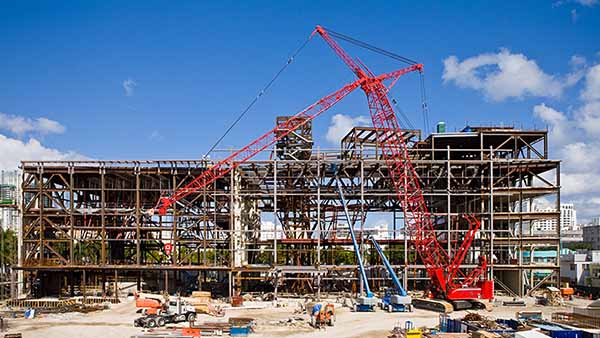
Comprehensive safety labeling and identification is a huge step in ensuring everyone knows how to stay safe when performing their jobs. It creates a safety-conscious environment and gives workers helpful information exactly where and when they need it. This contributes to health and safety in construction and improves job site safety.
Here's how good labeling makes a difference:
Creating a safe and efficient construction site requires a comprehensive approach to labeling. Let's explore 11 key areas where construction labels are essential.
OSHA's Hazard Communication Standard (HCS) provides guidelines to protect workers from the dangers of hazardous chemicals. Clear and informative labeling is a cornerstone of this protection. The HCS requires hazardous material labels that communicate the identity of the chemical, use a signal word like "Danger" or "Warning" to indicate severity, and include hazard and precautionary statements. These statements describe the nature of the hazards and recommended safety measures. Labels should also use standardized hazard symbols (pictograms) and provide manufacturer or supplier contact details.
Why is this so important? Because workers have a right to know what they're working with and how to protect themselves. Proper labeling empowers them to make informed decisions, handle chemicals safely and respond effectively in emergencies. To make your labels even more effective, go further by adding specific handling and first aid instructions, emergency contact information, and notes on any special storage requirements.
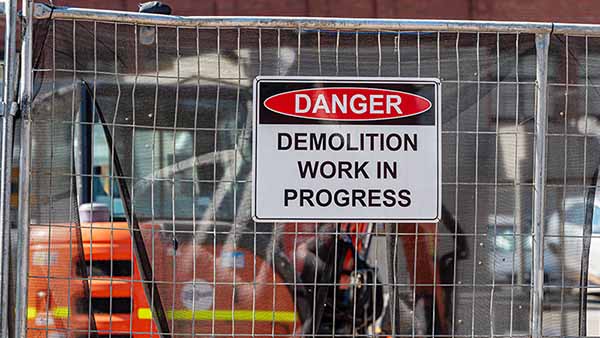
Clear labeling of pipes is essential for worker safety. Unidentified pipes can lead to confusion and dangerous situations, especially during maintenance or emergencies when workers need to quickly understand what's inside and which direction it’s flowing.
OSHA guidelines and the ASME (ANSI) A13.1 standard for pipe marking recommend labeling systems that clearly identify a pipe's contents, indicate flow direction, use color-coding and highlight any associated hazards like high pressure or extreme temperatures. To improve your pipe marking, choose durable pipe markers made for specific environments, place construction labels where they're easy to see and regularly inspect labels to make sure they're still legible.
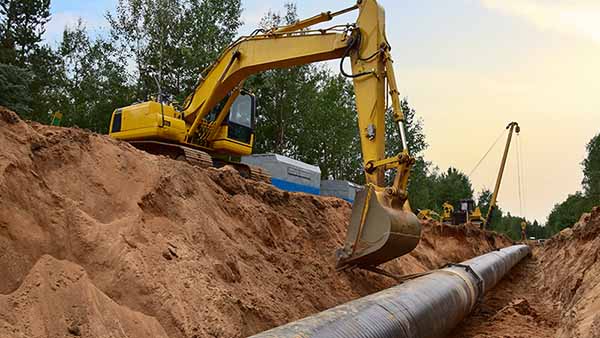
Falls are a leading cause of construction site injuries, making it critical to clearly mark and guard all elevated work areas. This includes obvious areas like leading edges and scaffolding, but also any location where a fall hazard exists, like stairs.
OSHA's Fall Protection Standard (29 CFR 1926.501) provides detailed guidance on protecting workers from falls. In addition to essential safeguards like guardrails and safety nets, OSHA highlights the importance of safety signage to define the boundaries of elevated work areas and alert workers to fall hazards. This includes marking leading edges, floor openings and areas with fall restrictions, such as skylights or fragile roofing, with floor and area marking tapes. By clearly identifying and warning of the dangers of these areas, you provide crucial visual cues that help prevent falls and keep workers safe.
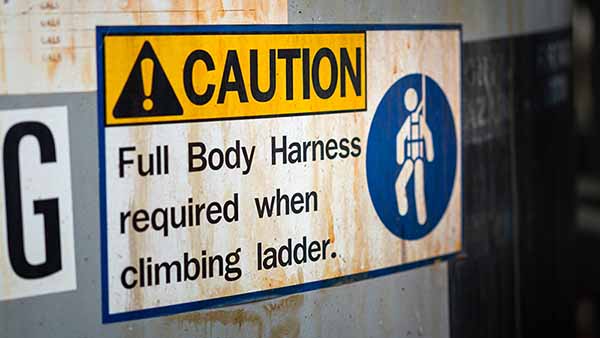
Working with electricity demands serious attention. Accidents involving electricity can have devastating consequences, including electrocution, burns and even fatalities. That's why accurate labeling of electrical wires, panels and circuits is crucial.
OSHA's Electrical Safety Standard (29 CFR 1910.303) outlines specific labeling requirements to prevent electrical accidents. This includes marking panels with voltage labels and arc flash labels as well as identifying circuits and marking wires to clearly indicate their function and any associated hazards. Proper labeling ensures that workers can identify live components, understand potential hazards and take necessary precautions to avoid accidents.
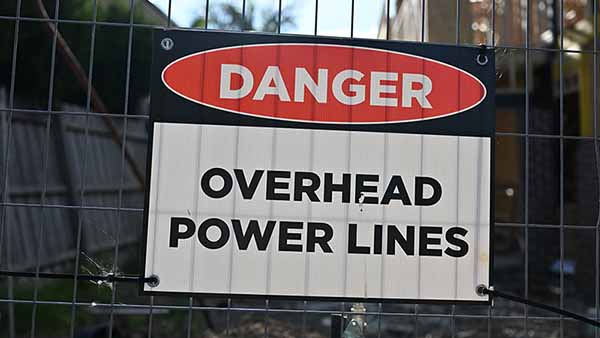
Clear labeling of structural components is essential for maintaining the integrity of a building and ensuring worker safety. This includes load-bearing structures and framing components, which need to be clearly identified to prevent overloading, collapse and other structural failures.
This is especially important during inspections and renovations when hidden structural elements may pose a risk to workers who are unaware of their presence or load-bearing capacity. OSHA’s Steel Erection Standard (29 CFR 1926.750 - Subpart R) relates to framing safety, including areas where labeling can help ensure a safe work environment.

Any recognized hazard on your construction site, from uneven ground and trip hazards to exposed rebar and sharp edges, should be clearly marked to alert workers and prevent accidents. This is not just a best practice; it's a legal requirement under OSHA's General Duty Clause, which mandates that employers provide a safe working environment free from recognized hazards.
You can use labels and safety signage to draw attention to these hazards. A strategically placed warning label can prevent slips, trips, falls and other injuries, contributing to a safer and more productive work environment.
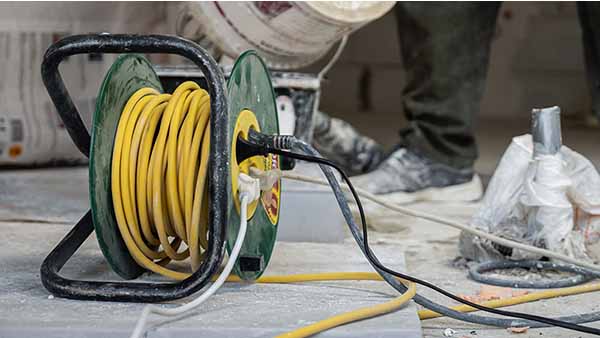
Proper labeling of stored materials is essential for maintaining a safe and efficient construction site. Clear and accurate labels not only help prevent accidents but also contribute to smooth workflows and organized inventory management.
For hazardous waste labeling, OSHA's Standard for Material Handling (29 CFR 1926 Subpart H) provides guidance. This includes identifying the contents, any associated hazards, and the date of receipt or manufacture with hazardous material labels to make them easier to locate, handle safely and track.
But even for non-hazardous materials, labeling offers significant benefits. Product and inventory labels identifying materials like lumber, pipes, bricks and other building supplies can significantly boost efficiency. Workers can quickly locate the materials they need, reducing downtime and improving productivity. Labels can also include information like quantity, size and date of delivery.
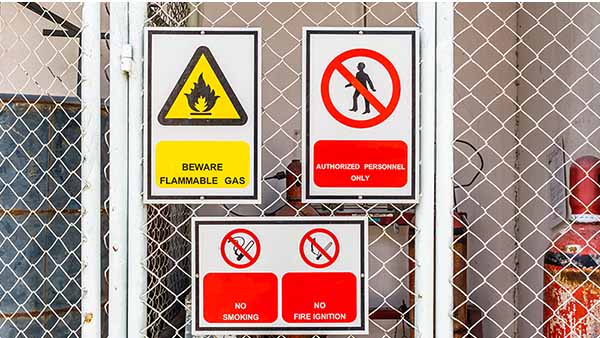
In an emergency, clear and readily available information can be the difference between life and death. Emergency exit routes and assembly points should be clearly marked on floor plans and identified prominently throughout the construction site with durable emergency signs. This is a key recommendation of OSHA’s Standard for Emergency Action Plans (29 CFR 1910.38).
Regularly review and update your emergency plans, ensuring all workers are familiar with the procedures. Conducting regular drills helps reinforce these procedures and ensures a swift and effective response in a real emergency.
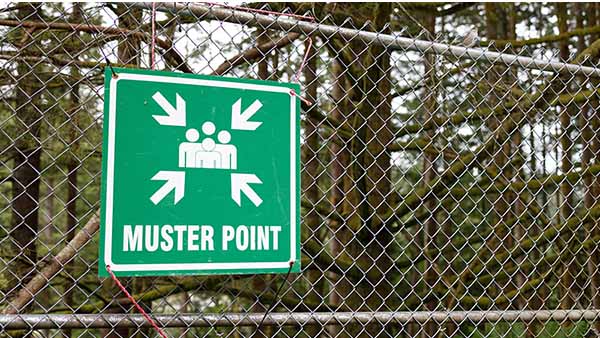
Scaffolding safety relies heavily on proper labeling. Clearly label load limits, access points and safety precautions on all scaffolding to prevent overloading and ensure safe usage. This includes providing information on maximum weight capacity, permitted access points and any specific safety procedures for erecting, dismantling or working on the scaffolding.
OSHA’s Scaffolding Standard (29 CFR 1926.451) mandates this labeling to prevent accidents and ensure worker safety. Regularly inspect scaffolding and update labels as needed to maintain a safe working environment.
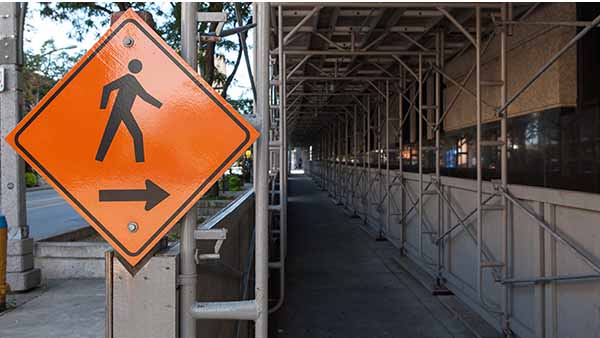
Site access and PPE signage should clearly communicate PPE requirements and any site-specific safety rules. This includes specifying the required personal protective equipment, such as hard hats, safety glasses, gloves and high-visibility vests, as well as any site-specific rules related to access, conduct or prohibited activities.
Ensure this signage is clear, concise and easily visible to all workers and visitors. Consider using visuals and multiple languages to ensure everyone understands the requirements.
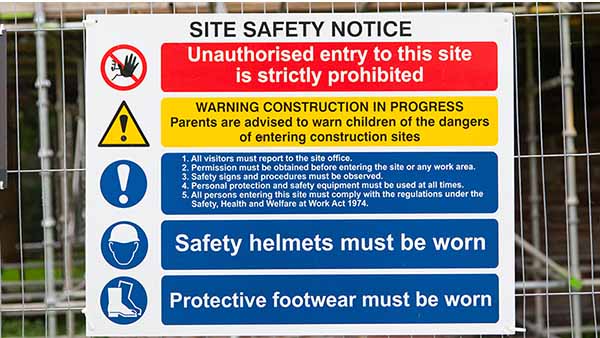
Clear worker identification procedures are crucial for maintaining a safe and organized construction site. This includes using name tags, badges and hard hat labels to clearly identify workers, their roles and any relevant certifications or qualifications.
OSHA mandates these procedures to ensure accountability, facilitate emergency response, and promote a safe work environment. Consider using different colored hard hat labels to quickly identify specific roles or certifications (e.g., foreman, electrician, first aid trained). This can be invaluable in emergencies and for general site management.

We know that a construction site demands identification that lasts. Whether you need to identify pipes, wires, hazardous materials or equipment, Brady labels and signs ensure your safety messages and critical information remain visible and intact throughout your project. Rely on Brady solutions to be:
Discover a full solution for effective communication, compliance and safety in commercial construction from Brady — the most trusted name in identification. We’re with you through every stage of a construction build and finished facility, offering unparalleled expertise. Explore our full construction solution and access an unrivaled range of identification products, services and cutting-edge software.

Safety label printers from Brady help you create effective ANSI-compliant visuals, including Danger, Warning, Caution and Notice signs and labels.
Print Safety Signs
Facility, equipment and safety labels, used to communicate warnings and provide direction to operators and employees.
Label Hazards Clearly
Ensure proper pipe and valve identification with durable markers and tags for safety and efficiency.
Identify Pipes and Valves
This guide will help you gain insights into the organizations that influence your daily work.
Understand Construction Compliance
Good or bad, every company has a safety culture, and your employees’ behaviors, knowledge, habits and beliefs about safety are what create it.
Enhance Workplace Safety Culture
Learn about common construction site hazards like fall hazards, electrical hazards, chemical hazards, and heavy equipment hazards to ensure a safe jobsite.
Prevent Construction Hazards